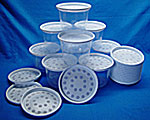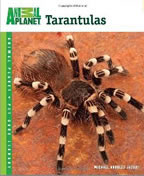Raising Young Tarantulas [aka "spiderlings"]
© 2000-2013, Michael Jacobi and TARANTULAS.com
Introduction
Raising young tarantulas is often the most rewarding aspect of the hobby for many keepers. Beginners are usually intimidated by the thought of keeping something so small and fragile and usually will choose to stick with adult tarantulas. However, once experience is gained, watching young spiders grow from a speck to hand-size and seeing the gradual transformation to adult coloration and pattern becomes a favorite experience. If you have never kept a tarantula in captivity I do recommend you start with a larger, adult spider (see Choosing A Tarantula). For those of you ready to accept the challenge of raising baby tarantulas, read on!
The Basics
Many people are surprised just how small many "big, hairy spiders" can be. Lasiodora parahybana ["Brazilian Salmon-pink"] gets as large as the average "Goliath Bird-eater" [Theraphosa blondi] — about 10" [250 mm], yet it begins life with less than a 0.25" [6 mm] legspan. The reproductive strategy of the former species is to have a very large number of young (often in excess of 2000 nymphs), few of which will survive to adulthood. However, the latter species has closer to 100 nymphs and these begin their lives with a legspan of almost 1" [25 mm]. The spiderlings [second instar or older] of most terrestrial species are about 0.25" [6 mm], whereas those of most arboreal species are at least 0.5" [13 mm] if not 0.75" [19 mm].
So how do we keep these little mini-tarantulas alive? It's easier than most inexperienced keepers believe. The key factors are using a small escape-proof container that provides somewhat elevated humidity without sacrificing ventilation, frequent feeding, and ensuring that uneaten food is removed promptly, especially during a molt cycle.
Housing
There are many types of containers that are useful in raising spiderlings. Most just require a little modification and many can be found at no cost. It is important to use a fairly small container so that the spider and its prey can "find each other" and eating and molting can be easily monitored. A 40 dram vial is perfect for most spiderlings. It is not so narrow as to make maintenance difficult and is not overly large. With small spiderlings the diameter of the container may be several times its legspan, but as it grows a container that is two or three times the diameter of the spider's legspan is ideal. A spider can be successfully raised to a 1" [25 mm] legspan in a 40 dram vial or baby food jar.
 The most popular spiderling rearing container is the vial such as that available through Thornton Plastics. Vials allow a good depth of substrate so the spiderling can burrow (which reduces the risk of desiccation) and they are clear so that the spiderling is easily visible (if not burrowed). Other suitable containers include baby food jars and 1-2 oz. [30-60 ml] plastic condiment cups. A container that I like to use for terrestrial is actually designed for displaying a Matchbox car (see Pioneer Plastics Model 164-C). Ventilation may be added to these containers by drilling very small holes in the lid, or, in the case of the vials, holes can be punched through with a miniature Phillips screwdriver. (Note: soldering irons, which are useful for putting holes in plastic containers housing larger spiders, make too large of hole to be of use for ventilating rearing containers].
The most popular spiderling rearing container is the vial such as that available through Thornton Plastics. Vials allow a good depth of substrate so the spiderling can burrow (which reduces the risk of desiccation) and they are clear so that the spiderling is easily visible (if not burrowed). Other suitable containers include baby food jars and 1-2 oz. [30-60 ml] plastic condiment cups. A container that I like to use for terrestrial is actually designed for displaying a Matchbox car (see Pioneer Plastics Model 164-C). Ventilation may be added to these containers by drilling very small holes in the lid, or, in the case of the vials, holes can be punched through with a miniature Phillips screwdriver. (Note: soldering irons, which are useful for putting holes in plastic containers housing larger spiders, make too large of hole to be of use for ventilating rearing containers].
So, let's assume that you have a baby food jar and you have cleaned it and drilled tiny holes in the lid for ventilation. Or maybe you have a clear vial with poked holes. The next step is to fill it half way with some type of substrate. Substrate choice is a matter of great debate among tarantula keepers. Garden soil, top soil, unfertilized/untreated potting soil, sphagnum peat moss, horticultural vermiculite and coconut coir (e.g., Bed-A-Beast, Eco Earth, Forest Bed) are most often used. I personally use a 50/50 mix of sphagnum peat moss and vermiculite. Both can be readily obtained at any nursery, home center or hardware store and are inexpensive. Vermiculite is used as a soil amendment to allow roots to breathe and water to be retained. It helps keep the mix from drying out and provides structural integrity to any burrows. I mix the two in equal parts in a storage tub and gradually add tepid water while stirring with a trowel until the blend just begins to clump when squeezed in a fist. If water is squeezed out it is too wet and you will need to add more substrate to dry the mix until it will barely clump together. Moisture content of the substrate may have to be slightly adjusted for species that require particularly dry or moist conditions, but, again, err on the side of dryness while trying to find the perfect balance. Even spiderlings of Asian species that live in deep burrows in humid forest will die from excessively damp conditions. In fact, I use extra caution to ensure that vials containing Haplopelma spiderlings do not become wet. Experience has taught me that even these "jungle dwellers" quickly succumb to wet and stagnant conditions. If the substrate begins to dry out it can be rehydrated with a brief light misting [avoiding the spider], or, better still, the spider can be removed [see Manipulating Spiderlings below] and the substrate can be moistened or replaced with fresh substrate.
I then fill the jar (or vial) halfway and pat down the substrate using my fingers or the butt end of the trowel. I then add a bit more and pat it down again until the jar is half full. Then I take the tip of a pencil or something similar and make a 1" [25 mm] deep hole towards the side of the container. This creates a "starter burrow" that most spiderlings will retreat to and expand on over time. Placing it near the side of the container often results in being able to see the spiderling even when its in the burrow. Many spiderlings will make their way all the way to the bottom and you will be able to clearly see it by looking under the container. Spiderlings will acquire the water they need from their prey [see "Watering and Feeding" below). They are too small to be given a water dish. At this point you can add your spider and secure the lid. Warm room temperatures [72-78ºF/22-26ºC] are sufficient for raising most species and an external heat source is not needed and often ill-advised. If you have a cool home you might want to use an aquarium with an undertank reptile heat mat or similar heating device as an incubator of sorts to house jars of spiderlings. However, make sure the jars are raised off the bottom of this tank so that they are not in direct contact with the heat source and that a thermometer is placed inside the larger container and temperatures do not exceed 82ºF [28ºC]. I recommend using a thermostat sold in reptile shops to control the heat source. As a rule, external heat sources should be used for arachnids only if necessary and ambient room temperatures should be tried first. Excessive heat may kill the spiderling and will contribute to the substrate drying quickly.
Deli-cup Style Containers for Larger Specimens
As spiderlings outgrow the containers discussed above they can be transferred to larger homes such as clear deli cups. I use clear Solo cups - 12 or 16 oz. for terrestrial species and 32 oz. for arboreal species. Once they outgrow these they may be ready for a permanent home such as an aquarium, plastic "critter keeper" or gallon [4 l] jar (for small arboreal tarantulas).
The Insect Cup for Better Ventilation
 I have become a big fan of using 16 oz. deli cups with insect lids [see Superior Enterprise] for all young tarantulas instead of vials. They provide significantly better ventilation than vials or similar containers and you can fill them with much more substrate. Having a greater depth and volume of substrate allows you to safely add more moisture less often. It will evaporate over time and provide beneficial humidity. At the same time, the great airflow offered by the insect lid reduces the risk of poor ventilation and stagnant conditions. An added benefit of the insect-style lid is that it prevents tiny flies and other pests from entering your tarantula's home.
I have become a big fan of using 16 oz. deli cups with insect lids [see Superior Enterprise] for all young tarantulas instead of vials. They provide significantly better ventilation than vials or similar containers and you can fill them with much more substrate. Having a greater depth and volume of substrate allows you to safely add more moisture less often. It will evaporate over time and provide beneficial humidity. At the same time, the great airflow offered by the insect lid reduces the risk of poor ventilation and stagnant conditions. An added benefit of the insect-style lid is that it prevents tiny flies and other pests from entering your tarantula's home.
Special Considerations for Tree-dwelling Species
Arboreal species, such as those of the genera Avicularia and Poecilotheria, will require slightly taller containers such as a 50 dram vial. For these types of tarantula I only fill the jar or vial about one quarter of the way with substrate, do not create a starter burrow and use a small sprig of silk plant (for Avicularia, Psalmopoeus] or a small piece of bark [Poecilotheria] to provide a climbing surface and retreat. Arboreal tarantulas, especially Avicularia, will typically create silken tube retreats at the top of the container. Misting is another topic of hot debate among tarantula keepers, but I generally give a very light misting - avoiding the spider itself - to the containers housing arboreal tarantula spiderlings once a week. I ensure that there is enough ventilation that the cage dries within a day or two. If the substrate becomes increasingly damp you should increase the ventilation or decrease the amount or frequency of misting. Damp, stagnant conditions are always to be avoided.
Watering and Feeding
As mentioned above, spiderlings are too small for water dishes and will obtain enough water from their prey as long as the container doesn't become very dry. Once a terrestrial tarantula has a legspan equal to or greater than a 2-liter soda bottle cap I begin to use said cap as a water dish. Always use fresh water. Do not use damp sponges or paper towel or cricket gel. Sponges quickly become dirty bacteria breeding grounds and are a thing of the past.
As also mentioned above, I do lightly mist containers housing arboreal species as they are often more prone to desiccation and typically are inhabitants of humid forest. However, many tarantula keepers are vehemently against misting. The key to doing it right is to be very conservative, avoid spraying the spider directly and ensure that the container dries out within a day or two and the substrate does not increase in moisture content. Once again, ventilation is more important than humidity - all other things being equal.
The one thing that makes most potential spiderling keepers nervous is feeding. Many people believe that "pinhead" crickets are necessary. The truth is that most terrestrial and some arboreal tarantula babies will scavenge and freshly killed larger crickets can be used as a food source. Some keepers just smash the head of the cricket, while others cut large crickets into a few pieces and offer each to an individual spider. Also, many people underestimate the size of cricket or other insect a spiderling will tackle. As a rule, a cricket should be offered that is approximately the total length of the spider's body (excluding legs). Some species are very aggressive feeders and will wrestle a cricket as large as their legspan to its death! Arboreal species have slightly larger spiderlings that will usually eat insects as large as their legspan and are often easier to find food for. Regardless, true "pinhead" crickets are not required. One week old crickets (0.125"/3 mm] are usually the right size for very small spiderlings. Baby roaches [especially from small species such as Nauphoeta cinerea ["Lobster Roach"], termites and maggots can also be used. Fruit flies are too small and their flight presents problems except for arboreal species, but some keepers do use them.
One of the most important things to remember when feeding spiderlings is to remove any uneaten food or remains of prey immediately the following day. Dead crickets will attract pests and produce odor. Live crickets can injure or kill a spiderling if it is fasting in preparation for a molt or is in the molting process (see "Molting" below). It is imperative that you monitor your spiderling's eating and keep its container clean.
An appropriately sized prey item twice a week is a good feeding regimen for spiderlings. Feeding less frequently will increase the risk of desiccation since the baby tarantulas are acquiring their water from their food. Some keepers like to "power feed" their spiderlings so that they grow quicker and will offer food daily as long as it is eaten. Whether this practice is detrimental to the health and lifespan of the spider is not known, but the same practice does have adverse resuilts in higher animals such as reptiles. Others will put several crickets in at a time, but if they are too large to be grabbed in succession the way an adult tarantula does the uneaten crickets [or other prey] may harass the feeding spider. I recommend sticking with one prey item at a time and feeding more frequently if desired.
Before leaving the subject of feeding I should answer a question that, as a dealer, I get quite frequently. That is, "How long should I wait after receiving my slings before feeding them?". Well, I have spent years instructing my customers to wait a few days for the spider to settle into its new home before offering food. However, it seems that most customers will email me to let me know their package arrived safely and let me know that the spiderlings are already eating. The fact is that even after being boxed up and shipped across the country most spiderlings that are not about to molt will never refuse a meal!
Molting
A tarantula needs to shed its exoskeleton periodically to allow for growth. Obviously, this molting process will occur with greatest frequency when it is young. Therefore, it is not unusual for a spiderling to shed every month or two. Since most tarantulas will fast for a period of days or weeks prior to a molt it is normal for spiderlings to refuse food every so often. That is usually the sign that a molt is coming (you should also notice its coloration to gradually become duller and its abdomen to darken). As mentioned above, it is essential that food is not offered at this time. By checking for remaining food every morning after feeding you will be able to prevent the spiderling from being killed by a hungry cricket that nibbles on it during a molt. I recommend waiting for about four days after a molt to offer food again. During this time the spider will grow and its new exoskeleton will harden. The spider will be particularly vulnerable at this time and should be left alone as much as possible. The molted skin [exuvium] should be removed as soon as possible after the spider is completely finished molting.
Manipulating Spiderlings
I almost called this section "Handling", but I certainly advise against handling small spiderlings. They are small, delicate and too easy to lose. But transferring them to another container or catching them should they come out of the container during feeding or maintenance is often necessary. The essential tool for this is a small artist's paintbrush. I use cheap ones from the dollar store. Gently brushing the spider is the best method of gently persuading it to move the direction you wish. Slightly larger brushes should be on hand for those keeping adult tarantulas. The use of a brush is safe and generally calms the spider rather than irritating it.
Record Keeping
I recommend that feeding and molting dates be recorded. As your collection increases it becomes more difficult to remember when each spider has been fed unless you only feed on a regular schedule. When a meal is refused you can make a notation that will remind you not to offer food again until after it has molted (assuming that is why it didn't eat). Keeping molting records is a fun way to track the spiderling's "progress" and will help you predict when it is due to molt and should be refusing food.
Sexing
Once a tarantula has reached a legspan of around 2" [5 cm] an experienced person can determine its gender using a stereo dissecting microscope to look for the absence or presence of spermathecae in the cast skin (exuvium). See Sexing A Tarantula.

